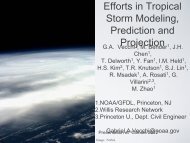Scaling-up: an overview of urban agriculture in North America
Scaling-up: an overview of urban agriculture in North America
Scaling-up: an overview of urban agriculture in North America
- No tags were found...
Create successful ePaper yourself
Turn your PDF publications into a flip-book with our unique Google optimized e-Paper software.
<strong>Scal<strong>in</strong>g</strong>-<strong>up</strong>: <strong>an</strong> <strong>overview</strong> <strong>of</strong> urb<strong>an</strong> <strong>agriculture</strong> <strong>in</strong> <strong>North</strong> <strong>America</strong>Matthew PotteigerL<strong>an</strong>dscape ArchitectureState University <strong>of</strong> New York
Fr<strong>an</strong>kl<strong>in</strong> Park, Boston1881 before construction“…relieved <strong>of</strong> a few houses, causeways <strong>an</strong>dfences,left with <strong>an</strong> unbroken surface <strong>of</strong> turf<strong>an</strong>d secluded by woods on the hillsides,this would at once s<strong>up</strong>ply a s<strong>in</strong>gularly complete<strong>an</strong>d perfectthough limited example <strong>of</strong> a type <strong>of</strong> scenerywhich is perhaps the most sooth<strong>in</strong>g <strong>in</strong> its<strong>in</strong>fluence on m<strong>an</strong>k<strong>in</strong>d <strong>of</strong> <strong>an</strong>y presented bynature.”-- Olmsted (from Zaitzevsky, Frederick LawOlmsted <strong>an</strong>d the Boston Park System)circa 1916
Fr<strong>an</strong>kl<strong>in</strong> Park, Boston1883 before construction“…relieved <strong>of</strong> a few houses, causeways <strong>an</strong>dfences,left with <strong>an</strong> unbroken surface <strong>of</strong> turf<strong>an</strong>d secluded by woods on the hillsides,this would at once s<strong>up</strong>ply a s<strong>in</strong>gularly complete<strong>an</strong>d perfectthough limited example <strong>of</strong> a type <strong>of</strong> scenerywhich is perhaps the most sooth<strong>in</strong>g <strong>in</strong> its<strong>in</strong>fluence on m<strong>an</strong>k<strong>in</strong>d <strong>of</strong> <strong>an</strong>y presented bynature.”-- Olmsted (from Zaitzevsky, Frederick LawOlmsted <strong>an</strong>d the Boston Park System)“Food desert” <strong>an</strong>dCommunity gardenscirca 1916
Questions:How has urb<strong>an</strong> <strong>agriculture</strong> responded toprocesses <strong>of</strong> de<strong>in</strong>dustrialization as well asexp<strong>an</strong>sion?What are the strategies to “scale-<strong>up</strong>” urb<strong>an</strong><strong>agriculture</strong>?How c<strong>an</strong> it have signific<strong>an</strong>t impact on thesocial, ecological <strong>an</strong>d spatial systems <strong>of</strong> thecity?
SeattleTorontoSyracuseNew YorkDetroitOakl<strong>an</strong>dPhiladelphiaCase studies/examplesNew Orle<strong>an</strong>s
Urb<strong>an</strong> Agriculture <strong>in</strong> 4 directions:Grow<strong>in</strong>g <strong>up</strong> -- vertical farm<strong>in</strong>gGrow<strong>in</strong>g <strong>in</strong> the urb<strong>an</strong> voidsGrow<strong>in</strong>g systemsGo<strong>in</strong>g public
Urb<strong>an</strong> Agriculture <strong>in</strong> 4 directions:Grow<strong>in</strong>g <strong>up</strong> -- vertical farm<strong>in</strong>gGrow<strong>in</strong>g <strong>in</strong> the urb<strong>an</strong> voidsGrow<strong>in</strong>g systemsGo<strong>in</strong>g public
PF 1 (public farm 1) atPS 1 (public school 1)Gallery run byMuseum <strong>of</strong> Modern ArtSummer 2008
Urb<strong>an</strong> Agriculture <strong>in</strong> 4 directions:Grow<strong>in</strong>g <strong>up</strong> -- vertical farm<strong>in</strong>gGrow<strong>in</strong>g <strong>in</strong> the urb<strong>an</strong> voidsGrow<strong>in</strong>g systemsGo<strong>in</strong>g public
Urb<strong>an</strong> <strong>agriculture</strong> <strong>an</strong>d vac<strong>an</strong>t l<strong>an</strong>dUrb<strong>an</strong> <strong>agriculture</strong> as vac<strong>an</strong>t l<strong>an</strong>d strategy
DetroitFrom 2,000,000 <strong>in</strong> 1950 to 800,000 <strong>in</strong> 2010Density:1950: 5,114.1/sq.km.2004: 2,469/sq.km.The city’s populationis likely to stabilize atbetween 500,000 <strong>an</strong>d600,000 by 2025
What this me<strong>an</strong>s for Detroit:Currently – 100,000 vac<strong>an</strong>t lots77.7 square km <strong>of</strong> vac<strong>an</strong>t l<strong>an</strong>dFuture – 227.92 square km <strong>of</strong> vac<strong>an</strong>t l<strong>an</strong>dReconfiguration <strong>of</strong> settlementRemoval <strong>of</strong> <strong>in</strong>frastructure
East side10 m<strong>in</strong>utes fromcenterDetroitRenaiss<strong>an</strong>ce Center (General Motors)
Detroit Community Gardens
Limitations <strong>of</strong> vac<strong>an</strong>t l<strong>an</strong>d strategy:• marg<strong>in</strong>alized activity• ambiguous public status• lacks spatial logicPhiladelphia community gardens <strong>an</strong>d real estate values • vulnerable to ch<strong>an</strong>ges <strong>in</strong> marketSource: Vittielo <strong>an</strong>d Nairn. Philadelphia HarvestNYC protests over mayor Giuli<strong>an</strong>i’ssale <strong>of</strong> gardens for development -113 sites spared by $4.2 millionpurchase <strong>an</strong>d held as l<strong>an</strong>d trust.
Urb<strong>an</strong> Agriculture <strong>in</strong> 4 directions:Grow<strong>in</strong>g <strong>up</strong> -- vertical farm<strong>in</strong>gGrow<strong>in</strong>g <strong>in</strong> the urb<strong>an</strong> voidsGrow<strong>in</strong>g systemsGo<strong>in</strong>g public
Vac<strong>an</strong>t sitesSyracuse, NY
Vac<strong>an</strong>t sites<strong>an</strong>d community gardensSyracuse, NY
¼ mile walk<strong>in</strong>g dist<strong>an</strong>ce<strong>Scal<strong>in</strong>g</strong> out, beyond the vac<strong>an</strong>t lot– “Networked Urb<strong>an</strong> Ag.”Social networks <strong>of</strong> s<strong>up</strong>port –Detroit Agricultural Network – now 900 gardensL<strong>in</strong>k<strong>in</strong>g sites <strong>in</strong>to systems <strong>an</strong>d <strong>in</strong>tegrat<strong>in</strong>gwith social, environmental <strong>an</strong>d spatial patternsVac<strong>an</strong>t sitesCommunity GardensAnd proximity toInstitutions <strong>an</strong>d Org<strong>an</strong>izations:SchoolsFood p<strong>an</strong>triesPublic hous<strong>in</strong>gChurches½ mile walk<strong>in</strong>g dist<strong>an</strong>ceYouth <strong>an</strong>d senior centers
<strong>Scal<strong>in</strong>g</strong> out – Networked Urb<strong>an</strong> Ag.– l<strong>in</strong>k<strong>in</strong>g urb<strong>an</strong> <strong>agriculture</strong> to other sectors <strong>of</strong> food systems-- l<strong>in</strong>k<strong>in</strong>g to advocacy around food security & social justice-- l<strong>in</strong>k<strong>in</strong>g to paradigm shift <strong>in</strong> public heath from <strong>in</strong>fectious diseaseto chronic health as a result <strong>of</strong> environment <strong>an</strong>d dietFood deserts <strong>an</strong>d food access
L<strong>in</strong>k<strong>in</strong>g urb<strong>an</strong> <strong>agriculture</strong> sites t<strong>of</strong>orm coherent urb<strong>an</strong> spatial <strong>an</strong>d ecological <strong>in</strong>frastructuresProvid<strong>in</strong>g ecological servicesMill Creek Farm, PhiladelphiaCommunity garden <strong>an</strong>d entrepreneurial farmL<strong>an</strong>d leased from city Water Authority
Philadelphia, PAMill CreekUrb<strong>an</strong> FarmHistoric pattern <strong>of</strong> streams Contemporary pattern <strong>of</strong> streams
Reconfigur<strong>in</strong>g Detroit (AIA design charette)• Urb<strong>an</strong> cores• Urb<strong>an</strong> agriculure• A network <strong>of</strong> Urb<strong>an</strong>Villages• ConnectivityL<strong>an</strong>d Use
Urb<strong>an</strong> <strong>agriculture</strong>as speculativedevelopmentstrategyCreate scarcity <strong>of</strong>l<strong>an</strong>d to drive <strong>up</strong>values
Urb<strong>an</strong> <strong>agriculture</strong>as speculativedevelopmentstrategy20 hectare “pod”Create scarcity <strong>of</strong>l<strong>an</strong>d to drive <strong>up</strong>values
Urb<strong>an</strong> Agriculture <strong>in</strong> 4 directions:Grow<strong>in</strong>g <strong>up</strong> -- vertical farm<strong>in</strong>gGrow<strong>in</strong>g <strong>in</strong> the urb<strong>an</strong> voidsGrow<strong>in</strong>g systemsGo<strong>in</strong>g public
Toronto, C<strong>an</strong>aadaGrow<strong>in</strong>g at rate <strong>of</strong> 100,000/yearEcological footpr<strong>in</strong>t 200 times actuall<strong>an</strong>d surface area1/3 <strong>of</strong> this is from food s<strong>up</strong>ply, themajority <strong>of</strong> which comes from globals<strong>up</strong>ply cha<strong>in</strong>sPotential for productive urb<strong>an</strong> public spaces:
Public spaces asProductive placesRom<strong>an</strong>owski Park, DetroitAg l<strong>an</strong>ds <strong>in</strong> Fairmount Park,Philadelphia
Oakl<strong>an</strong>d, CaliforniaAssessment <strong>of</strong> potential for urb<strong>an</strong> <strong>agriculture</strong> on pubic l<strong>an</strong>dsMcCl<strong>in</strong>tock, et. al. Cultivat<strong>in</strong>g the Commons. (2009)
Or<strong>an</strong>ge County Great Park, Irv<strong>in</strong>e California. 540 hectares
Or<strong>an</strong>ge County Great Park – Orchard componentSource: ASLA, 2008 Awards
Summary:Beyond the vac<strong>an</strong>t lotgrow<strong>in</strong>g <strong>up</strong>grow<strong>in</strong>g <strong>in</strong> the urb<strong>an</strong> voidsgrow<strong>in</strong>g systems – scal<strong>in</strong>g outgo<strong>in</strong>g publicProspectsnew municipal s<strong>up</strong>portQuestions/comments?







